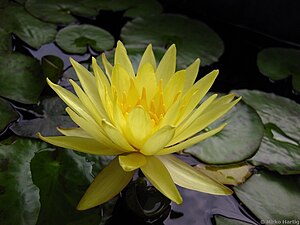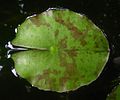Mexican water lily
| Mexican water lily | ||||||||||||
|---|---|---|---|---|---|---|---|---|---|---|---|---|

Mexican water lily ( Nymphaea mexicana ) |
||||||||||||
| Systematics | ||||||||||||
|
||||||||||||
| Scientific name | ||||||||||||
| Nymphaea mexicana | ||||||||||||
| Zucc. |
The Mexican water lily ( Nymphaea mexicana , syn .: Nymphaea flava Leitner , Castalia flava (Leitner) Greene ), also called yellow water lily (English common names Mexican water lily, yellow water lily or banana water lily ), is a species of the family of water lily plants (Nymphaeaceae) ).
description
The Mexican water lily is a perennial herbaceous plant . This aquatic plant forms an unbranched, up to 30 cm long, upright rhizome growing in the bottom of the water . This type of water lily does not reproduce like other species of this group by side shoots on the rhizome, but it forms stolons up to 1 m long . At the end of this a new plant or banana-shaped "wintering shoot" emerges. Hence the English name Banana-Waterlily.
The leaves have long stalks. The shield-shaped (peltate) leaf blade is oval to rounded and has a dark green color with brown-red spots. The leaf margin is jagged irregularly.
The yellow, hermaphroditic flowers, which stand up to 15 cm above the water, have a diameter of about 8 to 11 cm. The four free sepals are yellowish green and often reddish in color. The twelve to 30 free petals are yellow. The approximately 50 to 60 free, fertile stamens are yellow.
The spherical seeds have a diameter of about 5 mm.
The number of chromosomes is 2n = 56, 82 or 84.
Systematics
The variety Nymphaea mexicana 'Cape Canaveral' ( Nymphaea mexicana f. Canaveraliensis ) is larger in all parts, i. H. the leaves are up to 23 cm in diameter and the flower 15 to 20 cm. It also blooms in a more intense yellow.
The Mexican water lily is not - as is often claimed - a tropical water lily, but belongs to the hardy water lilies (subgenus: Nymphaea ), to which the white water lily ( Nymphaea alba ) also belongs (see also the graphic "Family tree of the water lily plants"). For this reason it can also be used to cross with other hardy water lilies, which according to the current state of the experts is not possible with the "real" tropical water lilies. However, it is not hardy in our latitudes.
The nature hybrid of Nymphaea mexicana with Nymphaea odorata is called Nymphaea × thiona D.B.Ward .
distribution and habitat
The Mexican water lily is found in southern Mexico and southern parts of the United States , southern Alabama, Florida, southeastern Georgia, southern Louisiana, southern Mississippi, eastern North Carolina, South Carolina, Arizona, Texas, and even in the United States southeastern Oklahoma.
The occurrence of the variety Nymphaea mexicana 'Cape Canaveral' is limited to Florida. There it was discovered by Frase in 1958 on the NASA site near Cape Canaveral.
Nymphaea mexicana usually grows in a water depth of about 30 to 40 centimeters.
More pictures
Mexican water lily ( Nymphaea mexicana ):
swell
literature
- Karl Wachter: Water lilies - hardy and tropical Nymphaeaceae. Ulmer Verlag 1998, ISBN 3-8001-6635-6
- Dieter Bechthold & Harro Hieronimus: Water lilies - Queen of the garden pond. , Dähne Verlag 2006, ISBN 3-935175-33-7
- Perry D. Slocum: Waterlilies and Lotuses - Species, Cultivars, and New Hybrids. Timber Press Verlag 2005, ISBN 0-88192-684-1
Individual evidence
- ↑ Nymphaea mexicana at Tropicos.org. In: IPCN Chromosome Reports . Missouri Botanical Garden, St. Louis
- ^ Nymphaea in the Germplasm Resources Information Network (GRIN), USDA , ARS , National Genetic Resources Program. National Germplasm Resources Laboratory, Beltsville, Maryland. Accessed May 31, 2018.


